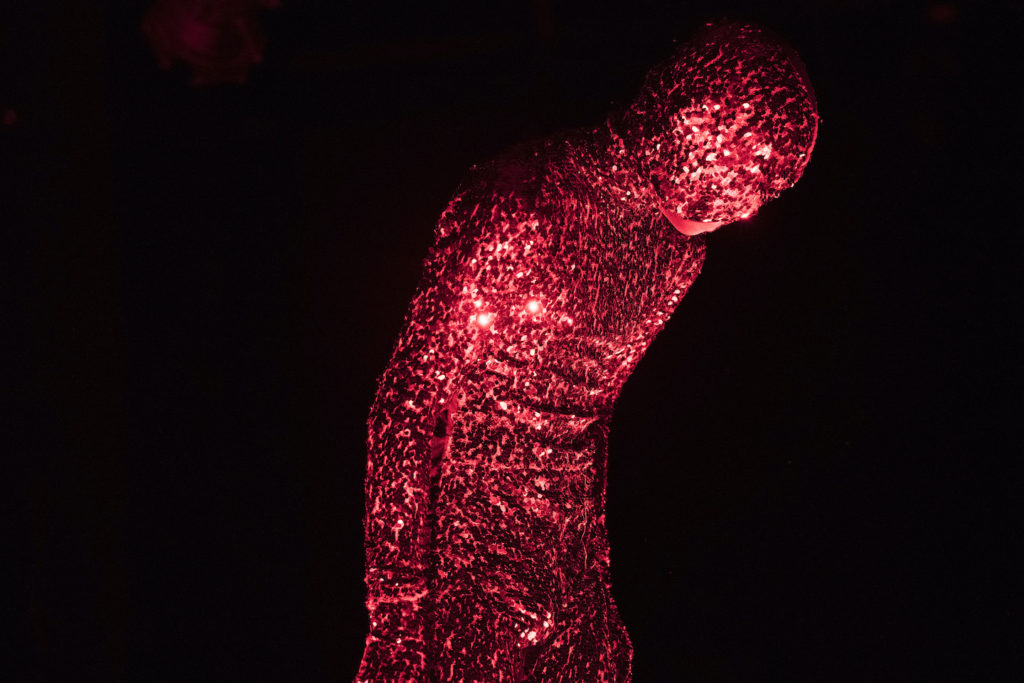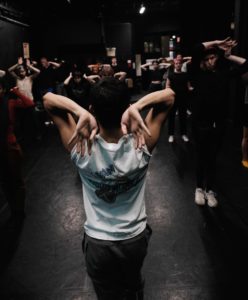Bridging divides: Ralph Escamillan wants to shake things up - Vancouver Ballet Society
- Home
- Features 2020 - 2023
- Bridging divides: Ralph Escamillan wants to shake things up

By Tessa Perkins Deneault
Ralph Escamillan’s gateway to dance was a breaking class at Harbour Dance Centre in Vancouver. He was 14, and during his first class they had a cypher, when everyone forms a circle and takes turns performing freestyle in the centre. “There was such a rush of excitement and fear, and that helped support me — I carry the feeling of that moment with me to this day.”
Escamillan became fascinated with all forms of street dance, and spent three years honing his skills in waacking, house, hip hop, breaking, locking and popping. He was soon taking as many classes as he could to develop not only his street dance skills, but also ballet, jazz and contemporary. He cleaned the studio in exchange for classes and got a part time job at a café across the street. He was at the studio every chance he could get — even during breaks at work.

The 27-year-old is now active in multiple dance communities as a performance artist, choreographer, teacher and community leader. His overarching goal is to bridge the divides among the many dance communities he works with.
While Escamillan’s first passion was street dance, he knew he wanted to train more broadly after seeing a show by Modus Operandi, a contemporary professional training program led by David Raymond and Tiffany Tregarthen in Vancouver. “I was 16, and contemporary was the right place to explore your emotions and who you are,” he says. “There was something about the contemporary way of making or using concepts to create movement that fascinated me.”
His first year of the Modus Operandi program was his last year of high school, and after graduating he moved to Toronto where he performed with urban dance company Gadfly. He was soon drawn back to Vancouver to perform in Paras Terezakis’ BOX4 for Kinesis Dance, and he decided to move back permanently after seeing a trailer of Vessel by Raymond and Tregarthen’s Out Innerspace Dance Theatre. “I felt like I was missing something. I hadn’t finished what I started.”
After a second year of the Modus program, he joined Vancouver’s 605 Collective at the Fall for Dance Festival in New York. He also began doing commercial work, including performing with Canadian singer-songwriter Victoria Duffield, as an ensemble dancer in Disney Channel’s Descendants and as a guest back-up dancer during Janet Jackson’s Unbreakable tour.
In 2014, Escamillan apprenticed with Kidd Pivot during the remount of Tempest Replica. “That experience really influenced a lot of my rigour,” he says, adding, “Crystal Pite’s superpower is her ability to give comfort to everyone in the room.”

Meanwhile, he was still active in the street dance scene, participating in battles and auditioning for more film and television roles. Balancing these worlds has its challenges. “It was a point of contention for some people in the contemporary world — they told me I’d have to choose one or the other.” In the street dance scene, colleagues asked him why he wanted to be a contemporary dancer. “I see my job as using my body as a medium to problem solve, regardless of the genre.”
Creating his own works under the umbrella entity of FakeKnot, Escamillan strives to bridge these seemingly contradictory worlds and attract broadly based audiences. “I wonder, how can I compel a well-known dance critic, my mom and a child to all like the work?”
When choreographing, Escamillan creates structures for himself using sound, costumes, set design, projection and lighting. Costumes are a huge catalyst for his creations; whip, which will premiere at MAI (Montréal, arts interculturels) next year, starts with large hoods by leather bag designer Fiveleft Leather. The dancers can’t see and can barely hear — the show is based on their loss of senses.
“I love the history of fashion and how clothing can change how people see you,” he says. “I think that’s related to me wanting to try different dance forms and shift the perception of how a body can move.”

To deepen his ballet experience, Escamillan asked Ballet BC artistic director Emily Molnar if he could intern with the company. He recently appeared onstage in their Romeo and Juliet and was scheduled to travel with them to Sydney in June, a tour that is now cancelled because of COVID-19 travelling restrictions.
“Ever since Modus, I’ve been thinking about how I can stir things up and put myself in places where I might not belong,” he says.
This year, he’s appeared with Wen Wei Dance in Flying White, in which he performs an intense finale using his body to brush thick black ink on a white canvas. He will perform in Privilege this May with Vancouver’s well-established post-modern Mascall Dance. His own choreography, HINKYPUNK, will be presented at the Festival of New Dance in St. John’s, Newfoundland, in October.
In vogue culture, there are “mothers” who mentor younger dancers and form a group with them, called a “house.” As the Mother of the Kiki House of Gvasalia, Escamillan is helping to develop Vancouver’s burgeoning vogue scene. He also runs classes and vogue balls through his non-profit VanVogueJam. He’d love to choreograph a piece for a large ensemble, and also hopes to establish a space in the city, similar to his by-donation voguing classes, where people can learn all dance styles for free. And he plans to pursue more film and television work, with a long-term goal of doing choreography or movement direction for that industry.
“I’ve learned, in the last few years, the importance of my skin and my ancestry and being a male-identifying queer person, who’s Filipino, and who comes from a diverse street dance background,” he says. As a result, he’s more thoughtful about which projects he takes on and how he’s being represented. “Right now, a lot of the projects I say yes to are things that challenge me. Why do something you already know?”

